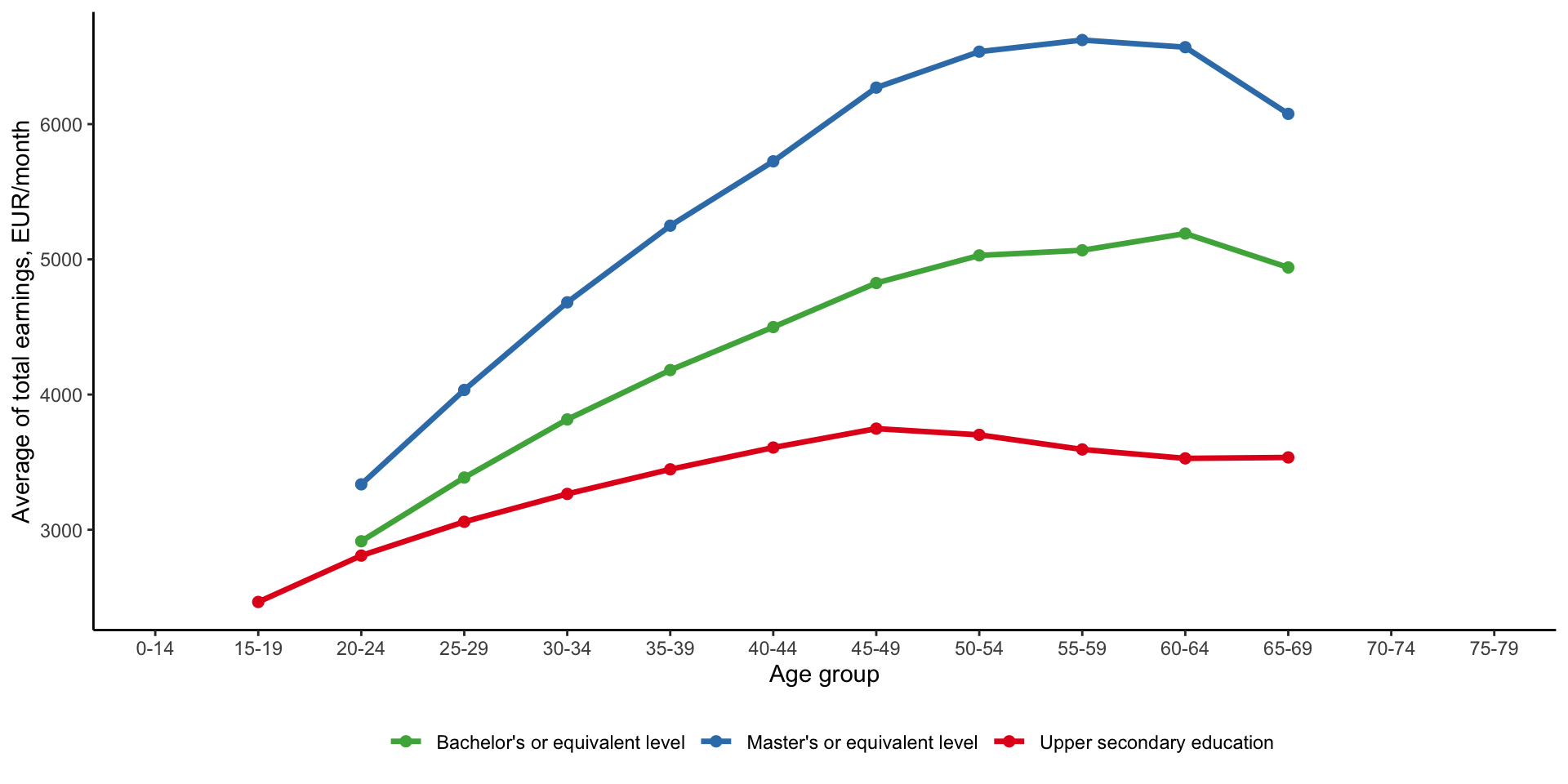
6. Human Capital
KAT.TAL.322 Advanced Course in Labour Economics
Human capital
Labour heterogeneity is important for labour supply and demand.
Human capital includes education, training, health investments.
First references as early as Adam Smith; formalised by Becker in 1960s.
Stylised facts
Overview
Human capital is an investment
- benefit: gain in earnings
- cost: tuition, foregone earnings, psychological costs
Two main camps for source of gain in earnings:
- gain in productivity
- signalling
Earnings by education
You might see this kind of figure a lot. It shows average monthly earnings of full-time workers by highest educational qualification across ages. There are two main observations we can get from this plot. Namely, that workers with higher education levels
- generally have higher level of earnings, and
- have faster earnings growth over time.
Both of these contribute to a substantial education premium in earnings over the lifecycle.
Human capital production function
Typically, univariate (years of education), it can be complex function of
- Innate skills (e.g., genetics)
- Parental investments (e.g., day care, time spent with children, tutors)
- Schooling/formal education
- Quantity (e.g., high school vs university)
- School quality (e.g., teacher quality, expenditure per student)
- Differences in curricula/fields (e.g., STEM vs arts)
- Peers (e.g., at school, at work)
- On-the-job training (e.g., general vs specific skills)
See Cunha and Heckman (2007) for a nice framework of pre-market production of skills
It’s worth mentioning that the term human capital is very vague. It is a set of all skills we have and acquire that help us produce some output. Even if we consider educational attainment as a measure of human capital, it can still mean a lot of things.
The most standard way is just to count years of education. It is the simplest and most universal variable available throughout the world. However, years of education may not capture the entirety of education (or human capital). For example, having 16 years of education with a bachelor degree can be valued differently from 16 years of same education but without the degree.
Besides the debate about productive and signalling value of education, the factors that create the education are numerous. Some of them are listed above. These factors can contribute differently to the overall output that we measure by years of education and/or qualifications. Therefore, change in overall education level can have different impact depending on which of these channels has generated the change.
In this lecture, we focus mainly on formal schooling and touch upon importance of innate skills and on-the-job training. For further discussion of determinants and consequences of education, you can check the references in the reading list.
Adult education
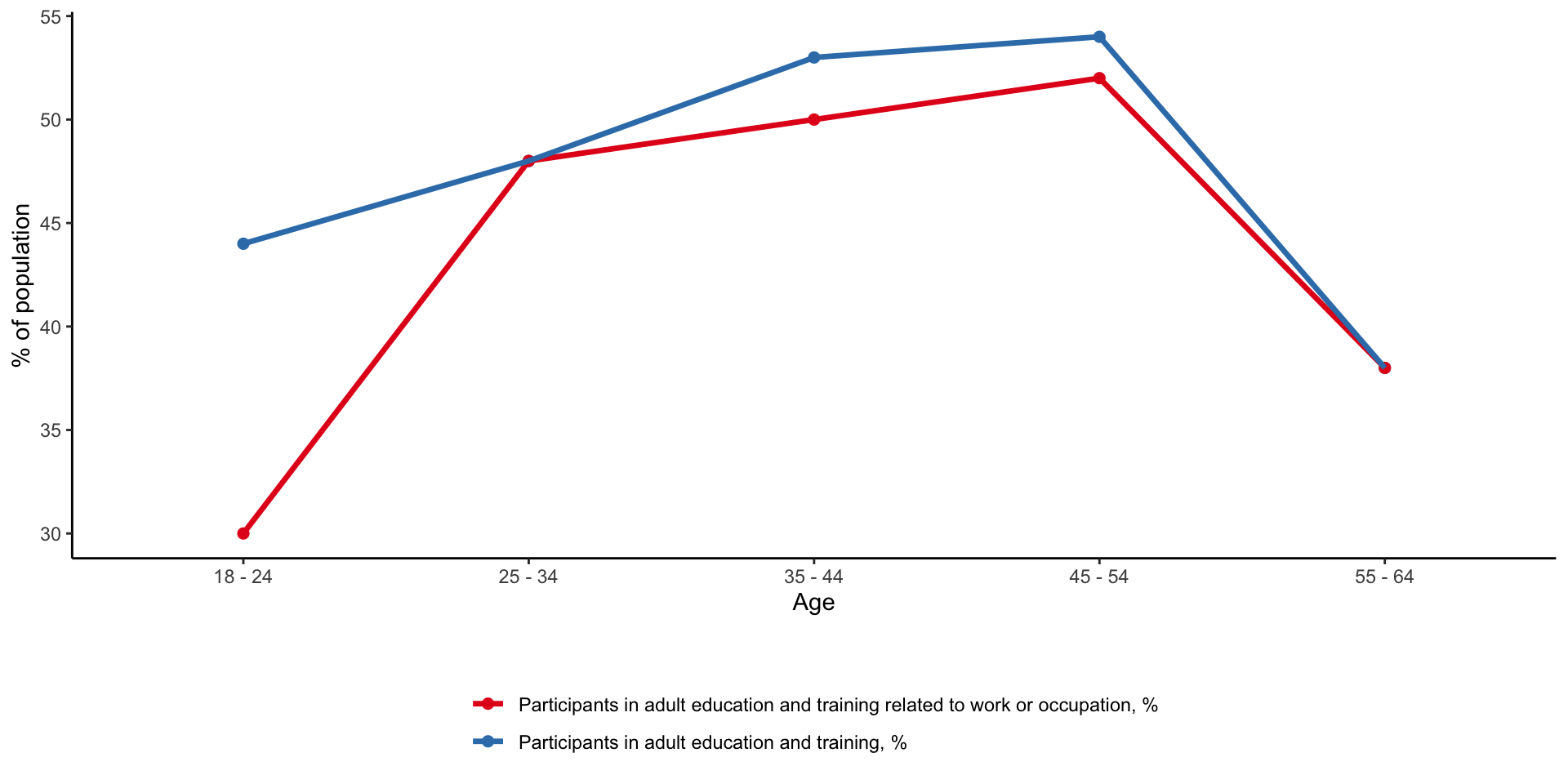
Another observation that we can explain in today’s lecture is participation in training after formal education has finished. The figure above plots share of population in a given age group that is participating in any form of adult education.
We can see that it tends to increase as people get older, but only up to a certain moment. Participation rate of pre-retirement age group - between 55-64 is much lower than participation rates of younger people.
We will see a model that aims to explain this lifecycle pattern in training.
Productive human capital investments
Basic model
Assume education choice
Worker with
Perfect competition ensures that
Assume cost of education given by function
Then choose college if marginal benefit outweighs marginal cost
We begin with a static model with homogeneous workers and perfectly competitive employers.
A worker can decide how much education to acquire. For simplicity, we can make a binary decision between attending university or starting to work right after high school. We assume that level of education determines marginal productivity of each worker. In other words, in this model education enhances productivity. A worker with high-school diploma can produce
Under perfect competition we know that each worker is paid their marginal productivity. Therefore, worker with high-school diploma earns
If this were all, then everybody would be interested in getting university degree, which isn’t the case in real life. So, we must assume that education is costly. Note that even though this model is static, the cost function
A worker chooses to get university education if and only if her utility with univeristy education is at least as high her utility with only a high-school diploma. Here, we also implicitly assume linear risk-neutral utility function. Therefore, we can write down the decision rule using wages and cost of education directly. Therefore, the worker chooses
So, according to this model, people invest into education because it raises their productivity. It is worth noting that this investment decision will also be influenced by any possible market failures. In particular, it is one of the classical examples of positive externality. Raising education level of population may additionally benefit the society through better health, higher civic engagement, lower criminality, etc. All of these mean that social benefits of education may outweigh individual benefits (higher lifetime earnings). As a result, market equilibrium delivers lower education levels compared to equilibrium reached by the benevolent social planner. This is main reason why many countries around the world invest heavily into formal education.
Lifecycle model: simplified Ben-Porath (1967)
- Divide time between schooling/training
- Law of motion of HC:
- Production function per worker:
- Assume linear utility and no utility cost of
Marginal return to HC effort
We have seen at the beginning that education decision may not be taken at a single point in time. Rather we continually make decisions about formal or informal education throughout our lives. We can study this dynamic decision-making using lifecycle model (Ben-Porath 1967).
Here, a worker has 1 unit of time at each
Education is still a productive activity. That is, the more time we spend on education, the higher is her human capital. To formalise this argument we write down the law of motion for human capital (recall that
- individual heterogeneity
- time spent in training
- existing level of human capital
Thus, if someone is innately very good at learning, she will learn more and faster. If someone devotes a lot of time to education, she will learn more and faster. If someone already knows a lot, she will learn more and faster.
As before, the level of human capital determines marginal productivity of the worker
Again, we assume perfect competition. Hence, equilibrium wages are equal to marginal productivity of worker
Finally, assume linear utility with no utility cost of
This is true for every time
To solve this, take the first-order derivative of
To develop this further we need to know
Divide both sides by
Now, let’s write the expression for the entire evolution of human capital since
Exponentiate both sides and write down an expression for
Now, we are ready to take partial derivative of
The last term is a functional derivative of a function:
In our case,
Plug this into the first-order derivative of
As highlighted above, the terms have economic meaning. The first term captures opportunity cost of foregone earnings. Whenever a worker devotes
Again, the optimal allocation of time is such that marginal cost of education (foregone earnings) is equal to marginal benefit of education.
Note that here we assumed that there is no other cost of education. If there is direct cost of education, the FOC above will be augmented to account for it.
Lifecycle model: simplified Ben-Porath (1967)
Optimal effort is zero at low efficiency
The change in marginal return over time is given by
If
Hence, marginal return at every period is negative
Take the derivative of
When
Now, let’s look at the marginal utility of
From this we deduce that marginal utility of
This result is saying that if an individual has very low efficiency in learning (low
Lifecycle model: simplified Ben-Porath (1967)
Optimal effort when efficiency
Marginal return
- initial investment into education
- work rest of the time
- study longer if
This is the opposite case of a worker with high efficiency
We can also write an explicit expression for
From the previous derivations we have that
And we said that
Therefore, the equality of marginal utilities can be rewritten as
After simplifying and rearranging we get
After further simplifications we can write
You can also verify that

Lifecycle model: Ben-Porath (1967)
Allows for human-capital depreciation and on-the-job training
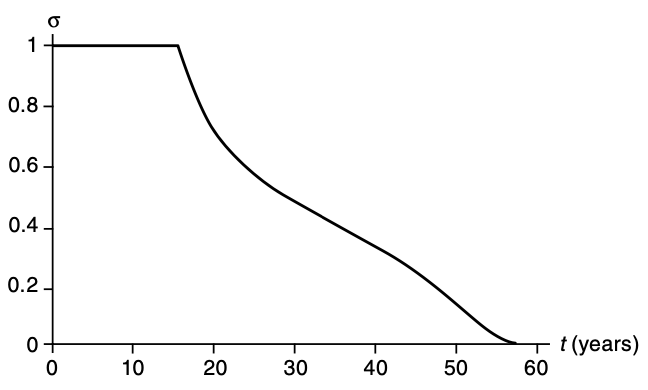
The full version of lifecycle model in Ben-Porath (1967) also allows for human capital depreciation over time. Therefore, workers have incentives to keep investing into learning after they fully enter labour market. However, similar forces are going to shape the optimal decisions here. Devoting time to learning means that the worker doesn’t earn as much. But acquiring more human capital helps to get higher earnings in the future. So, there is still going to be a point in time
Signalling theory
Basic model
- Two types of productivity
- Education
- Linear utility
Now, we consider the other camp of modelling investment into education. In this version, education is not a productive investment - it does not raise worker’s productivities directly. Instead, it is a tool that employers can use to learn about worker types.
The basic idea is that employers don’t have full information about workers. They don’t know actual worker productivities.
For simplicity, let’s start from the model where there are two types of workers
Workers may choose to invest into education. It does not affect their productivities - those stay
If employers did have full information, the we know that equilibrium under perfect competition is such that wages are equal to marginal productivities. Hence,
Now, let’s imagine that employers announce that they pay
Solution steps:
In a separating equilibrium, the types do not want to pretend to be of other types
Given that costs
Given the separation condition, the optimal education level of high type is
A few things to note:
Productive theory suggests that people under-educate themselves because of positive externalities. Signalling theory, however, says people overeducate themselves! Since education does nothing to productivity, it is only an annoying cost that people have to put up with. So, in the best-case scenario, nobody would get any education, but now they have to.
Notice that the equilibrium is equivalent to one achieved with full information. But workers have to pay extra cost of acquiring education. Thus, total welfare is lower.
Returns to education
J. Mincer (1958)
- Assume no direct cost of education
- Internal rate of return:
Present value of earnings
| Regression | |
|---|---|
| 0.067 |
Linear utility, no direct cost, no heterogeneity => can estimate actual returns (net of costs = 0)
Otherwise, the estimates only show “revenue” side of story.
J. A. Mincer (1974)
Accounting for experience
Building on Ben-Porath (1967)
- HC law of motion:
| Regression | |
|---|---|
| 0.285 |
Steps:
- Integrate HC law of motion:
- Assume again that
- Assume linear decay of training function:
- Plug in the above and
Notes:
- Parameter
- Estimate of
- Signals that experience was an omitted variable and estimates on the previous slide likely suffer from omitted variable bias
- Experience and schooling are negatively correlated
OLS estimates of returns to schooling
Potential issues
Endogeneity of schooling and earnings
- Cognitive and noncognitive abilities (Heckman, Stixrud, and Urzua 2006)
Return to education is same regardless of duration of study
Does not take into account direct costs of education
Heterogeneity of returns (e.g., family background, schooling system)
Years of schooling vs qualifications
Productivity vs signalling interpretation
More on these in Card (1999)
Causal estimates of returns to schooling
Angrist and Krueger (1991)
Compulsory schooling laws: exogenous variation by quarter of birth
Instrumental variable approach
Local Average Treatment Effect (LATE)
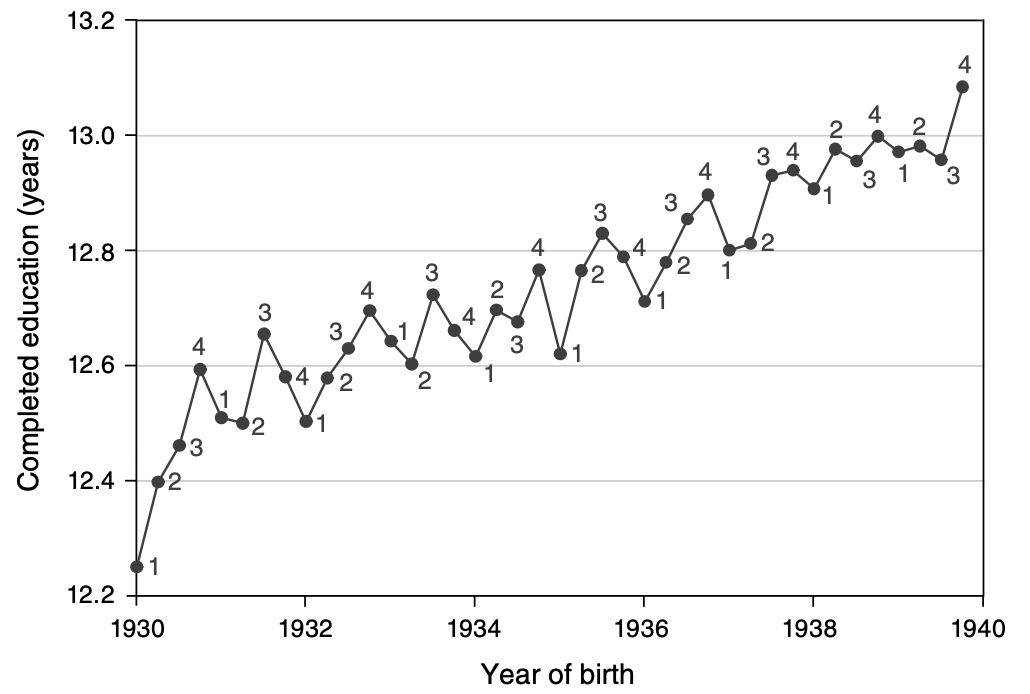
Causal estimates of returns to schooling
Angrist and Krueger (1991)
IV estimates of returns to education
| cohort30 | cohort40 | |
|---|---|---|
| r | 0.076 | 0.095 |
| (0.029) | (0.022) | |
| Weak IV F-stat | 1.6 | 3.2 |
Issues:
Instrument is weak (IV estimates are inflated)
Who are the compliers? Endogeneity? External validity?
Compliers represent only 0.46% of the population (extrapolation issue)
Compliers are also people that optimally choose min schooling
their baseline returns to schooling is likely to be low
but because of low base, an exogenous shift in years of schooling can overestimate marginal return to schooling among these people
Quarter of birth is a very weak instrument => estimates are inflated!
Trends within cohorts (may not have been fully accounted for by detrending and could reflect changes in the schooling system)
Endogenous choice of year and quarter of birth by parents
Causal estimates of returns to schooling
Some other IV approaches
| Instrument | Estimated |
|
|---|---|---|
| Card (1993) | Proximity to college | 0.132 (0.055) |
| Cameron and Taber (2004) | Proximity to college | 0.228 (0.109) |
| Cameron and Taber (2004) | Earnings in local labour market | 0.057 (0.115) |
| Kane and Rouse (1995) | College tuition fees | 0.116 (0.045) |
| Oreopoulos (2007) | Changes in compulsory schooling laws | 0.133 (0.0118) US 0.084 (0.0267) Canada 0.158 (0.0491) UK |
Causal estimates of returns to schooling
Twin studies
| Estimated |
|
|---|---|
| Ashenfelter and Rouse (1998) | 0.088 (0.025) |
| Oreopoulos and Salvanes (2011) | 0.0476 (0.0026) |
Variation in schooling between twins
- This is difficult to justify!
Causal estimates of returns to schooling
Regression discontinuity design: Oreopoulos (2006)
UK 1947: raised min school leaving age (ROSLA) from 14 to 15
Compare similar people just before and after policy change
Estimated
Second reform in 1972: min SLA
Small (or zero) return (Dickson and Smith 2011)
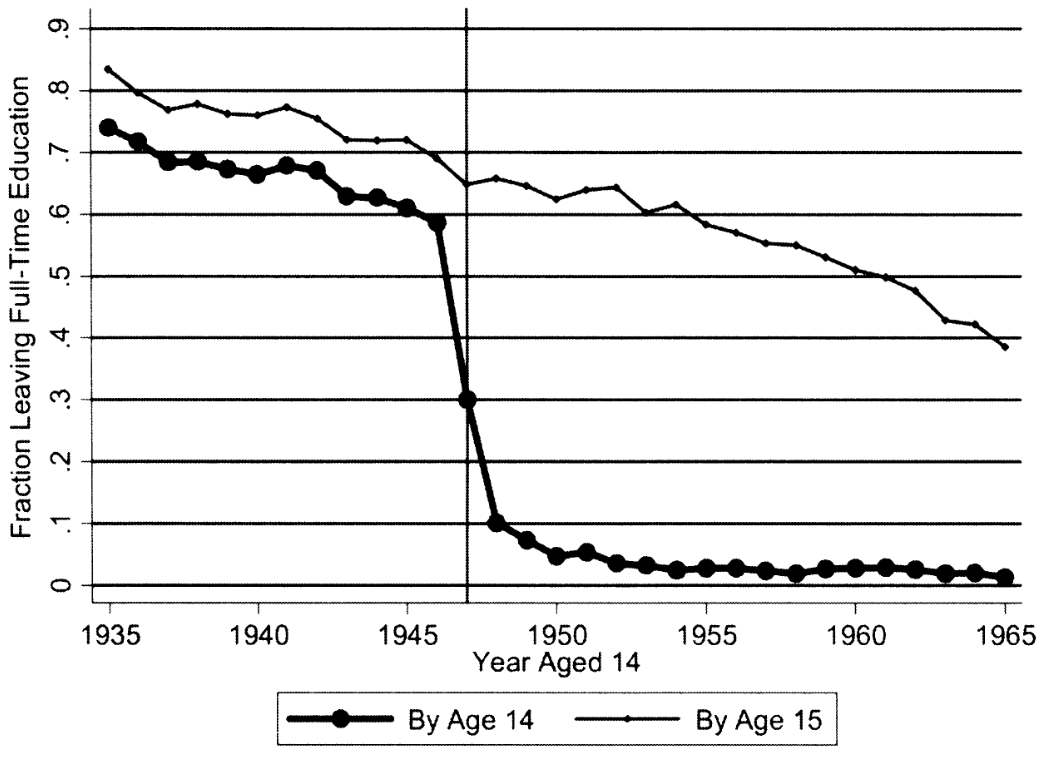
Potential questions:
- If returns are so high, why do they not stay up to age 15 to begin with?
Causal estimates of returns to schooling
Carneiro, Heckman, and Vytlacil (2011)
- Many papers estimate sizable returns to schooling
- Average dropout rate in OECD 17% in 2020
- Heterogeneity in returns to schooling
Role of individual characteristics? E.g., patience (Cadena and Keys 2015)
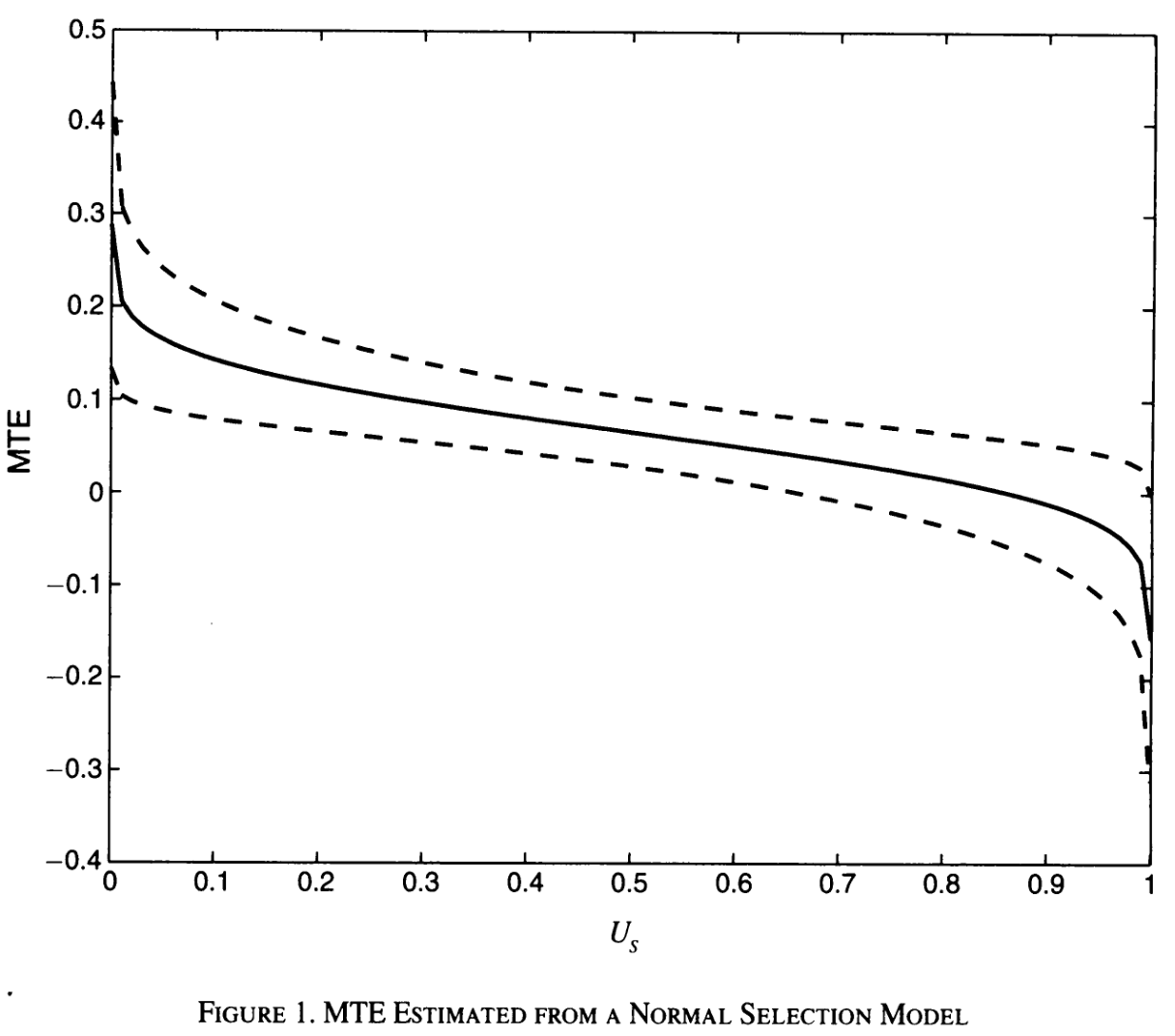
IV estimates = average of MTE, at best
Significant selection on gains:
dropouts already have very low returns (or negative)
those who stay have very high returns to education
Policy relevant effect thus depends on where along this curve the policy bites
Causal estimates of returns to schooling
Productivity or signalling?
Hard question to answer
Highlight that qualifications have both “productivity” as well as “signalling” parts
Summary
Education is a human capital investment
Models describing the investment decisions treat education as productivity enhancing and/or signalling device
Empirical estimates suggest sizable wage returns to a year of schooling
However, still a lot of debate about causality, heterogeneity and interpretation
Next lecture: Education Quality on 15 Sep